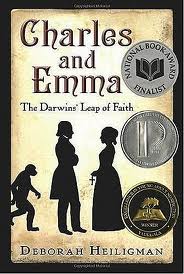Charles and Emma: The Darwins’ Leap of Faith by Deborah Heiligman
Reviewed by Jennifer

2009 National Book Award Finalist
2010 Printz Honor Book
Ratings Explanation
Language: A few religious exclamations and a couple of swear words.
Sexual Content: Some discussion of animals mating and sexual behavior in animals and humans. Charles anticipates marriage and intimacy.
Adult Themes: Charles and Emma deal with the deaths of several family members. Charles struggles with his religious questions and with his decision to publicly challenge the Biblical account of the creation. He worries about the reaction that people of faith will have to his theory.
Synopsis
In his late twenties, Charles Darwin knew it was time to decide whether he would marry or not. Drawing a line down the middle of a piece of scrap paper, he made two headings: Marry and Not Marry. The Not Marry list included points like, “to have the expense & anxiety of children – perhaps quarrelling” and “Loss of time”, which was underlined twice. And my personal favorite, “Cannot read in the evenings – fatness and idleness – Anxiety & responsibility – less money for books &c if many children forced to gain one’s bread.”
But the side of Marry also contained some important items, for example, “constant companion (& friend in old age) who will feel interested in one–” and “Home, & someone to take care of house — Charms of music & female chit-chat. –These things good for one’s health.” Though the two lists were similar in length, Charles felt that the arguments supporting marriage outweighed those for staying single. So it was decided; he would marry.
Charles married his first cousin, Emma Wedgwood, in 1839 and together they had 10 children. The decision to marry Emma proved to be monumental both personally and professionally for Charles. He was lucky enough to find in her the love of his life, a woman who loved, supported and genuinely cared for him for the rest of his life. She nursed him through literally years of illness, read all that he wrote and, although she did not agree with some of his theories, offered insight and suggestions for improving his writing. Charles was always interested in Emma’s reaction to his writing as she was a “representative of the religious world he was up against” and she always gave him her honest opinion.
Emma was a woman of faith who believed strongly in God, the teachings of Jesus Christ and an afterlife. Charles had been open with her before their engagement, telling her of his religious doubts and his theory of natural selection, which denounced the Biblical account of creation. Even though they disagreed in this area, they decided that they would take a leap of faith and start a life together. Their marriage was not only one of man and woman, but also of science and religion. Charles and Emma takes the reader along for the journey as the Darwins build a life, a family and a groundbreaking scientific theory.
First of all, let me recommend this book – highly. I was fascinated by this intimate look into the life of Charles and Emma Darwin and their family. Their relationship was extraordinary. They disagreed on a very weighty subject, that of religion, but were respectful of each others opinions and views. Emma worried about Charles’s soul and whether they would be together in heaven or not and on more than one occasion asked him to read certain passages in the Bible and consider them. Charles would always comply with her wishes, but he would never lie to her. He could not believe in the Bible and he would not pray. It seems that neither of them ever tried to force the other to accept their beliefs or opinions.
According to the author, Charles was always an “English gentleman”. He waited years before publishing his theory of natural selection, mostly because he was very concerned about the social reaction it would inevitable incite. He had many friends and family members who were religious and he did not want to offend them. Charles did not hate religion or those who had faith. The popular belief of the time was that God created “every single species as it existed now, unchanged.” Through his travels and observations, Charles had discovered first hand the “modification by natural selection” apparent in different species and did not believe that God had created every single variation. Rather, he believed that each species survived based on its ability to adapt to its environment.
I honestly felt enriched after having read Charles and Emma. They are an incredible example of perseverance through trials and seemed to have been a truly loving and happy family. Charles was a gentle and loving father and Emma devoted her entire life to serving her husband and family. Whether one agrees with his theories or not, his contributions to science and research cannot be denied. I was grateful for this reminder and to have the opportunity to learn more about how he developed his theories. I definitely have a new admiration for Darwin.
Charles and Emma is written for young adults which was great for me because the science was very understandable. What an incredible opportunity to read with your children and discuss science, religion and what you believe about the two. My daughter is in line to read this next, and I am anxious to discuss it with her. An excellent and educational book.








